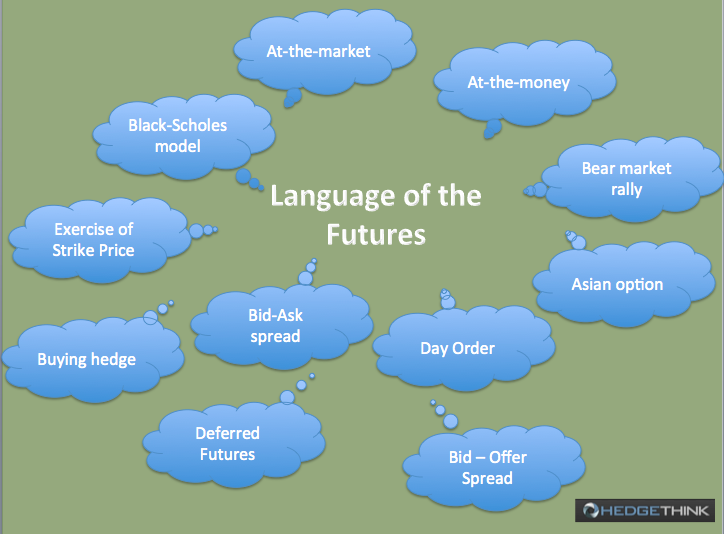Futures is defined as a specific financial contractual obligation that enjoins upon the buyer to purchase an asset or alternatively, for a seller to sell an asset which could either be a physical commodity or a financial instrument, at a prefixed future price and date. Futures can be used for speculation and or to hedge against fluctuating price movements of the underlying asset. For instance, a corn producer can lock in a particular price and hence, decrease his risk (hedge against) against possible price movements.
There are certain terms that one must be familiar with when it comes to the sophisticated Futures industry.Some of the main ones are explained here:
- Abandon: As the term implies, this means that the option holder does not opt to exercise or offset the option, but instead allows it to lapse at expiry.
- Actuals: These are the particular tangible commodities either physical or cash based in nature such as metals, agricultural produce or money used for buying and selling as opposed to hedging or speculating via trading on the futures contract.
- Aggregation: This is a principle that underlines all futures positions that are owned or managed by one trader or one trading entity so as to report status and compliance with the speculative position limits.
- At-the-Market: This is a futures order to buy or sell at the best possible price when the order reaches the trading pit.
- At-the-Money: This is when the particular options strike price is equivalent to the current trading price of the underlying commodity.
- Automatic Exercise: This is the process whereby an option holder is protected via automatic generation of an in-the-money option by a certain amount, when the said option approaches its expiration date. This occurs when there are no instructions given by the option holder pertaining to the futures contract.
- Asian Option: Alternatively called the Average option as well, is an option that generates a payoff which is associated with the average value of the underlying on a particular sets of dates within the duration of the option. This option is more commonly used, as it is much cheaper than the American option.
- Basis: This is described as the difference between the price of a futures contract and its spot or cash price, typically quoted as the latter subtracted from the former.
- Bear: This is described as a market where the market trend is generally on the downward, or the person anticipates that the prices will decline; opposite of a bullish market. A financial market that is exhibiting low asset prices is said to be bearish and coupled with investor pessimism, lack of confidence and diminishing expectations. Investor psychology has a prominent role to play in a bearish or bullish market.
- Bear Market Rally: This is when there is a temporary rise in prices in a bearish market.
- Bid: This is a very common term used in the futures and derivative industry, and is the offer to buy a particular quantity of a commodity at a stated price.
- Beta: This is a very important measure of the variability in the rate of return or the value of a stock or portfolio as compared to the general market. The risk measured by the beta is often called the systematic risk (overall market risk) and is commonly used in the capital asset pricing model (CAPM).
- Bid- Ask Spread or Bid-Offer Spread: This is the particular difference in spread of the bid price and the ask/offer price.
- Black-Scholes Model: This is a very useful option-pricing model developed by Fischer Black and Myron Scholes for securities options initially, and then extended to futures options as well. This is a model of price fluctuation of financial securities over time and can be used to determine the price of a European call option
- Buyer: A person who participates in the financial market by taking long futures position or buying an option.
- Buyers Call: This is a purchase of a particular quantity of a specific grade of commodity at a predetermined number of points, above or below a determined month of delivery futures price. The buyer is allowed a certain period of time to fix the price by purchasing a futures contract for the sellers account or by ordering the seller to fix the price on his behalf.
- Buying Hedge: This is a hedging transaction in a futures contract that allows the contracts to be protected against potential increases in the cost of commodities.
- Call: This is an option contract that gives the buyer the right but not the obligation to buy a commodity or any underlying asset or to enter into a long futures position at a fixed price or prior to a specified time duration.
- Cover: This is the process whereby futures are purchased to offset a short position.
- Day Order: This is a type of order that automatically expires at the end of each days trading session and may or may not include a time contingent clause.
- Deferred Futures: A futures contract that expires automatically in the coming months.
- Exercise: To elect, to buy or sell in order to exploit the advantage of the right but not the obligation conferred on the option holder.
- Exercise or Strike Price: This is the price specified in the particular option contract with which the buyer of a call is able to purchase the commodity during the validity of the option contract, and the price that is mentioned in the option contract at which a buyer of the put can sell the commodity during the lifetime of the option.
Related Post:
Guide to Research on Hedge Funds: Part 1 Introduction
Guide to Research on Hedge Funds: Part 2 Essentials
HedgeThink.com is the fund industry’s leading news, research and analysis source for individual and institutional accredited investors and professionals













































